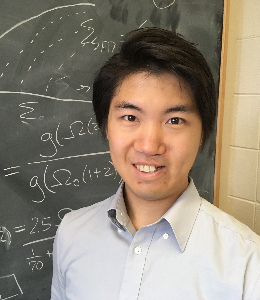NPP Fellow Aaron Yung gets the opportunity of a lifetime

Aaron Yung, Ph.D., is a NASA Postdoctoral Program Fellow at NASA Goddard Space Flight Center. He's a theorist working on what he calls the "mission of the century," the James Webb Space Telescope team. He has been making predictions via galaxy models for the JWST team since he was a graduate student five years ago. During this conversation, host Michael Holtz and Yung discuss the science behind predictive modeling and what it means to be a scientist telling the story of the universe.
Center: Goddard Space Flight Center
NASA Postdoctoral Program Fellow Aaron Yung has done so much with NASA that his job description sounds almost mythical.
“The point of being a scientist is that you are now the explorer of the tribe of humanity,” Yung said. “Now for what I do, I see the universe, and then I come back and tell everyone, ‘This is what the universe is like.’”
Sounds dramatic, but the vastness of what Yung has been exposed to during his time at NASA can’t really be understated. He’s a fellow at NASA Goddard Space Flight Center, focusing on theoretical modeling. He creates simulations of the unknown universe to help perfect the James Webb Space Telescope (JWST). There, he’s gotten to reap the benefits of 30 years of groundwork laid before him. Thankfully for Yung, the opportunity was one he sort of just fell into.
“When I graduated with my Ph.D. back in 2020, I was looking for a postdoc job, and no one hired me at that time,” Yung said. “My work was okay, but no one hired me. So, the NPP program offered a chance to apply and work with NASA, which needed people to work on JWST.”
Through the program, Yung has gotten to participate in a mission much bigger than just one person. It’s something he seems to wear as a badge of honor. As a kid, Yung didn’t have access to astronomy’s best materials, yet his curiosity has steamrolled him to the forefront of space exploration.
“You know, when I was a kid, I was curious, but I did not know there are people that study the universe,” Yung said. “I didn't have those resources, didn't know that these books existed, but now I do.”
Fast forward a few years and Yung is sitting in the lobby of his Stockholm hotel, spending the wee hours of his morning with colleagues and champagne as they anticipate the first images retrieved from the JWST since its launch.
“When we received the first full-resolution image from JWST, which was 300-something megabytes in a JPEG file, we zoomed in and looked at the glorious detail. It's almost like doing your own sightseeing in the deep universe,” he said. “Now we get to see what the universe is like, and ask ourselves, ‘Do we understand what is going on in there or is there more for us to discover?’”
As always in science, there’s always more to learn. Yung accepts that challenge. As big of a task as understanding the universe is, Yung gets no greater joy than trying to find the answer to that question.
